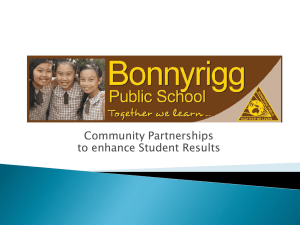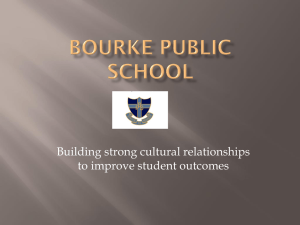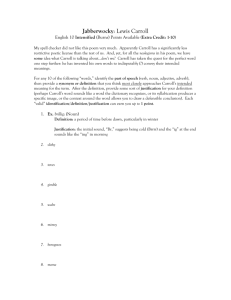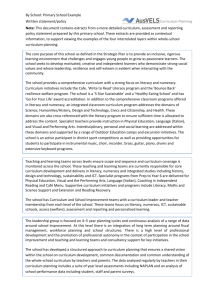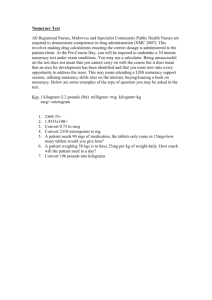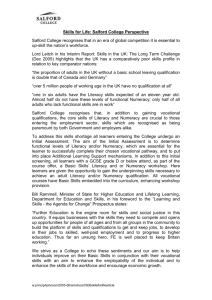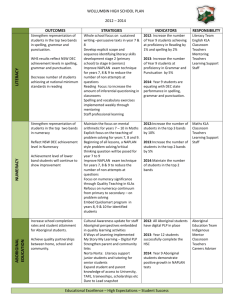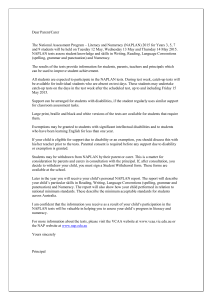docx, 742 KB - Carroll Public School
advertisement
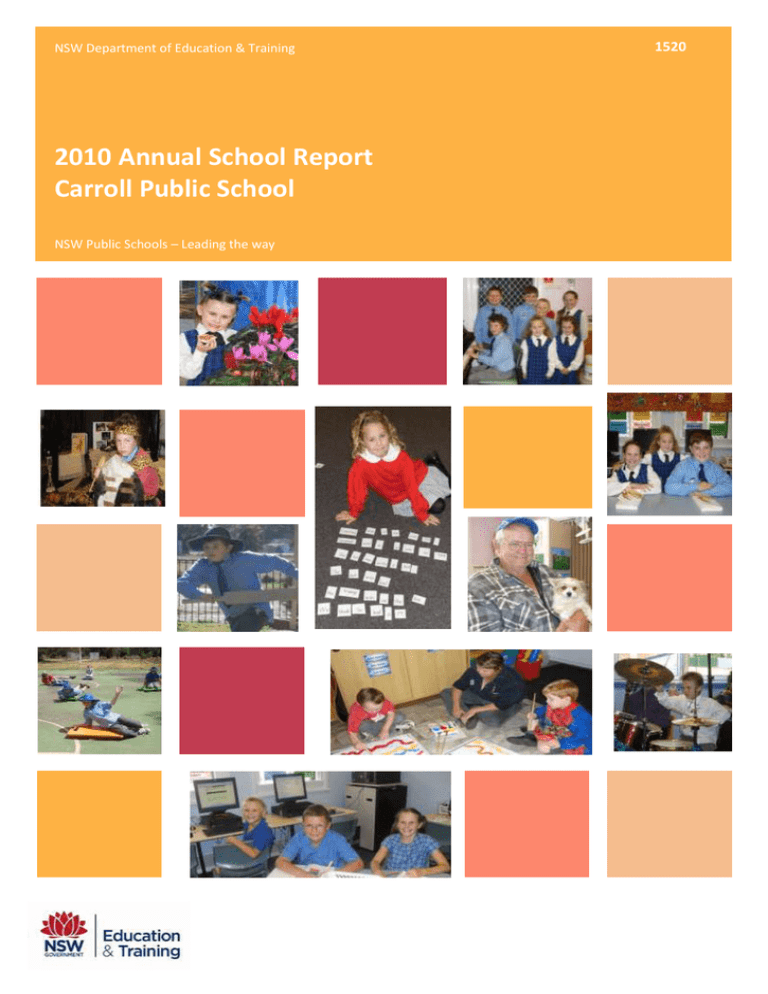
NSW Department of Education & Training 2010 Annual School Report Carroll Public School NSW Public Schools – Leading the way 1520 Messages Christine Patison Principal’s message It is my pleasure to present the 2010 Annual School Report for Carroll Public School. The report represents a snapshot of the school’s many achievements and successes throughout 2010. I invite parents and community members to reflect upon our achievements and highlights during the past year, and to also read about our plans for the future. Carroll Public School is a small rural school situated on the Oxley Highway between Gunnedah and Tamworth. The school is the focus of the community and provides a vibrant, happy and caring learning environment. Our students enjoy personalised and exciting learning programs and are supported by a school that is dedicated to working hand-in-hand with parents and the community. Mr & Mrs Don Walker, Ms Patison and students with a photograph of George Francis Walker & Rebecca Lucy Walker—first teacher of Carroll Public School. P & C and/or School Council message For quite a large portion of the 2010 school year, Carroll Public School had only five students from three families. It was therefore decided that the P&C as such, simply become a fundraising committee until the beginning of 2011. As a result, we were very pleased to be able to contribute financially to the major excursion to Sydney in Term 4 which was an absolute highlight for our children, most of whom had never been to Sydney before. I am always delighted to hear the many positive comments that the school receives from its visitors. Daily, visitors remark on the beautiful garden areas and school grounds and the happy and welcoming environment that permeates the school. It is within this environment that students work conscientiously and cooperatively to achieve excellent results and it is within this environment that staff, parents and community members work hard to achieve excellence in all aspects of schooling. We look forward to activating our P&C again in 2011 and continuing our work in supporting the students and staff of Carroll Public School. Robyn Hattam – P&C President For further information about Carroll Public School, please call at the office and ask for a copy of our handbook. Alternatively you are very welcome to make an appointment to visit our school. I certify that the information in this report is the result of a rigorous school self-evaluation process and is a balanced and genuine account of the school's achievements and areas for development. Christine Patison On our way to Sydney but just a quick stop in the Hunter Valley for horse riding! 1 Student representative’s message School context As captain of Carroll Public School, I really enjoyed representing the school as student leader. Some of my duties included welcoming visitors to the school, assisting the younger students with their work, officiating at our Annual Presentation Night and generally helping out. Student information It is a requirement that the reporting of information for all students must be consistent with privacy and personal information policies. Student enrolment For the students the two biggest highlights of the year were the Magical Musos to Maestros program and our major excursion to Sydney. Every week, Brad Patison (percussionist and guitarist) and Chloe Charody (international classical composer) came to the school and taught us lots of things about music. In term 3, we started having individual tuition in drums and guitar after school. The drum lessons were awesome and by the end of the year, we were reading, writing and performing our own drum scores. Our excursion to Sydney was mad. Most of us hadn’t been to Sydney before. We went on the Manly ferry at night and saw the great lights of the harbour as well as the Sydney Opera House. We went to Taronga Zoo and caught the sky lift which took us above many of the animal enclosures. We also got to see Tukta, the little Asian elephant born at the zoo last year. Male Female 2006 11 5 In 2011, we enrolments. 2007 9 5 look 2008 7 3 2009 4 3 2010 4 3 forward to increased Student attendance profile We participated in the Small Schools Swimming Carnival, the Gunnedah Eisteddfod, AFL Auskick and performed at the Gunnedah Schools’ Spectacular. We are looking forward to our Magical Musos to Maestros program in 2011 and our major excursion to the Jenolan Caves. Attendance rates in 2010 were well above state and regional average. At the end of each year at the school’s Annual Presentation Evening, students are rewarded for regular attendance. Caleb Faint -2010 School Captain Management of non-attendance Attendance rates are monitored very closely. Student absences are noted on class rolls and the school requests that parents/carers explain absences by written communication, in person or by telephone. Any unexplained absences are followed up with either a phone call or a standard note requesting explanation. A Partial Student Absence Register has also been set up. Parents can come into the classroom, explain the absence in the register and sign it. It is then countersigned by the principal. Through the weekly school newsletter, parents and carers are reminded of Beautiful little Tukta (Thai name meaning doll) enjoying her day at Taronga Zoo. 2 their obligations under the Education Reform Act and the likely course of action if absences continue. If necessary, the school will make referrals to the Home School Liaison Officer if a student’s attendance continues to be unacceptable. The National Education Agreement requires schools to report on Indigenous composition of their workforce. In 2010, no staff members employed at Carroll Public School were of Aboriginal or Torres Strait Islander descent. Class sizes Staff retention In March 2003 the Government announced its commitment to publish primary class sizes in annual school reports in order to provide parents with as much local information as possible. We are fortunate to have retained the same experienced and supportive staff for a number of years at Carroll Public School. Mrs Ruth Norris, our part-time teacher, has been teaching at the school for over 20 years. Mrs Beverley Carter, our Administration Manager has been at the school for 10 years. Our Learning Support Officers; Miss Meegan Constable, Robyn Hattam and Sandra Faulkner have been working at CPS for 13, 4 and 2 years respectively. The principal and the General Assistant have been at the school for 4 years. The following table shows our class sizes as reported at the 2010 class size audit conducted on Wednesday 17 March 2010. Roll Class K-6 K-6 K-6 K-6 Year Total per Year Total in Class K 2 4 5 2 2 2 1 7 7 7 7 Structure of classes There is one multistage (K-6) class at Carroll Public School. Staff information We are very lucky to have such dedicated staff at CPS. It is a requirement that the reporting of information for all staff must be consistent with privacy and personal information policies Teacher qualifications All teaching staff meet the professional requirements for teaching in NSW public schools. The school has one full time teaching principal. This is a dual administrative/teaching role. There is also one part-time teacher. The teaching staff are supported by a School Administration Manager, two part-time Learning Support Officers and one part-time General Assistant. Qualifications Degree or Diploma % of staff 100% Staff establishment Position Principal / Teacher Primary Part-time Teacher Primary Teacher RFF Teacher Librarian Priority School Funding Scheme School Administrative & Support Staff Total Number 1.00 0.084 0.042 0.084 0.1 0.814 2.124 It’s not all hard work at Carroll Public School! 3 variety of activities in the Arts. Some of these are outlined below. Financial summary This summary covers funds for operating costs and does not involve expenditure areas such as permanent salaries, building and major maintenance. Date of financial summary: Income Balance brought forward Global funds Tied funds School & community sources Interest Trust receipts Canteen Total income Library Training & development Tied funds Casual relief teachers Administration & office School-operated canteen Utilities Maintenance Trust accounts Capital programs Total expenditure Balance carried forward Students participated in a Musical Outreach program conducted by musical trio Chloe Charody (Young Australian Composer of the year -2008), violinistSonja Shebeck who had just returned from a European tour with virtuoso, Nigel Kennedy, and Ambre Hammond (internationally renowned pianist). The students took part in simple composition exercises and experimented with improvisation and the organisation of sounds. At the conclusion of the workshop our students were treated to a performance of classical music composed in the 21st century by one of Australia’s finest classical ensembles, Illythian . Private afterschool tuition in percussion and guitar. Participation in the Gunnedah’s Schools’ Spectacular where our small group of only four children sang and danced their hearts out to an audience of over 500 people. Students’ artwork was exhibited at the Gunnedah Show. Year 4 student, Bowen Tochel received a book prize for his literary work in a competition run by The Smith Family and the Gunnedah View Club. 30/11/2010 $ 67346.85 37442.62 31714.92 2278.17 2399.83 196.50 0.00 141378.89 Expenditure Teaching & learning Key l ea rni ng a rea s Excurs i ons Extra curri cul a r di s s ecti ons 8793.06 -1295.18 755.80 0.00 1281.85 34971.30 3047.59 15233.03 0.00 6250.71 12677.95 196.50 13602.17 95514.78 45864.11 A full copy of the school’s 2010 financial statement is tabled at the annual general meetings of the School Council and/or the parent body. Further details concerning the statement can be obtained by contacting the school. School performance 2010 Achievements Arts At Carroll Public School we strive for excellence in creating an environment that promotes and fosters creativity, personal growth and success. In 2010 students were again able to participate in a Mary Poppins, Bert and their two pet penguins ready to hit the stage at the Gdh Schools’ Spectacular! 4 The program focussed on the development of fundamental movement skills as well as the teaching of AFL skills. This was an outstanding program and in 2011 we will again be registering. Jeremy Hattam receiving a donation from Gunnedah Eisteddfod committee members, Mrs Amos and Mrs Baxter Sport Regular fitness and sporting activities are seen as an essential part of growth and development for our students. In 2009 a diverse program of sport and physical activities, with an emphasis on sportsman like behaviour, underpinned a welfare program that promoted a healthy body and mind. Okay Katie, what do we do now? Academic In the National Assessment Program, the results across the Years 3, 5, 7 and 9 literacy and numeracy assessments are reported on a scale from Band 1 to Band 10. Small Schools Swimming Carnival At the beginning of the year students participated in the Small Schools Swimming Carnival at the Gunnedah Shire Pool. Other small schools to participate included Mullaley, Tambar Springs. Fairfax and GS Kidd. Our students enjoyed a wonderful day. Special mention must be made of two of our students, Shakira Tochel and Jeremy Hattam both of whom demonstrated excellent sportsmanship by competing in a number of races. Our younger students enjoyed participating in the novelty events and it was wonderful to see parents from our school encouraging and supporting their children and others on this day. The achievement scale represents increasing levels of skills and understandings demonstrated in these assessments. Yr 3: from Band 1 (lowest) to Band 6 (highest for Year 3) Yr 5: from Band 3 (lowest) to Band 8 (highest for Year 5) Literacy – NAPLAN Year 3 In 2010 there were no students in year 3. Numeracy – NAPLAN Year 3 As above. NAB AFL Auskick School Program Literacy – NAPLAN Year 5 During 2010, AFL (NSW) again launched an NAB AFL AUSKICK program designed specifically for primary school students in northwestern NSW. Carroll Public School registered once more for this program. AFL AUSKICK Instructor, Katie Howard conducted two clinics on two consecutive days during terms 2 and 3 culminating in a Gala Day of skill development, modified games and fun activities in term 4 with children from other schools. At CPS the number of students in year 5 completing the National Assessment Program was not great enough that students could not be individually identified through comments on the results of these tests. Numeracy – NAPLAN Year 5 Progress in literacy For matched students (those students who sat NAPLAN in year 3 and again in year 5, our 5 progress was very pleasing as indicated on the graphs presented below. Average progress in grammar & punctuation between Year 3 and Year 5 Average progress in reading between Year 3 and Year 5 120 140 100 Progress 120 Progress 100 80 80 60 60 40 40 20 20 0 2008 - 2010 0 2006 - 2008 2007 - 2009 2008 - 2010 School School SSG SSG State DET State DET Progress in numeracy For matched students, our progress from year 3 to year 5 was very pleasing. Average progress in writing between Year 3 and Year 5 140 Average progress in numeracy between Year 3 and Year 5 120 140 80 120 60 Progress 100 40 20 0 School SSG 80 60 40 2006 - 2008 2007 - 2009 2008 - 2010 20 State DET 0 2006 - 2008 2007 - 2009 2008 - 2010 Average progress in spelling between Year 3 and Year 5 140 School 120 State DET The Commonwealth Government sets minimum standards for reading, writing, grammar and punctuation, spelling and numeracy for years 3, 5, 7 and 9. 80 60 40 20 The performance of the students in our school in the National Assessment Program – Literacy and Numeracy is compared to these minimum standards. The percentages of our students achieving at or above these standards are reported below. 0 2008 - 2010 School SSG Minimum standards 100 Progress Progress 100 SSG State DET 6 Percentage of Year 3 students in our school achieving at or above the minimum standard in 2010 In 2010 there were no students in year 3. Percentage of Year 5 students in our school achieving at or above the minimum standard in 2010 The number of students in year 5 completing the National Assessment Program was not great enough to enable a report to be generated. Significant programs and initiatives Aboriginal education Carroll Public School continues to provide support for Aboriginal students and to educate all students about Aboriginal history, culture and modern Aboriginal Australia. During 2010, this was achieved through classroom programs and learning experiences. Aunty Ellen giving us a hand with our ‘Johnny Cakes’! Bush Tucker Day We were delighted to receive an invitation to Gunnedah High School’s Bush Tucker Day in Breeza. The day was organised by Ann Thomas – Plan-it-Youth Coordinator, Danny Lickorish from Reconnect and Helen Lickorish –Aboriginal Education Officer at Gunnedah High. Our students enjoyed eating food that had been cooked in a traditional bush oven. The feast included kangaroo, lamb, potatoes, carrots and parsnips (cooked underground). Simone Lickorish made old fashion jam rolls and there was also a beautiful curried chicken made by Breeza local, Mrs Gail Taber. Early in the morning we went on a tour of Breeza Station. Mr Andrew Pursehouse, owner of Breeza Station led a very informative session on the history of this very old property. NAIDOC Week NAIDOC Week at Carroll Public School was celebrated over a two day period. Third year practice teaching student, Chloe Cornish organised our celebrations giving students, staff and parents the opportunity to participate in a range of activities to help celebrate and support our local Aboriginal people. We were honoured to have highly respected and Aboriginal elder, Ellen Draper (Aunty Ellen) spend the first day with us. Aunty Ellen conducted the Flag raising ceremony and led the Welcome to Country. She delighted students and staff with her wonderful Aboriginal Dreamtime stories and was on hand to give advice during the preparation and cooking of ‘Johnny Cakes’. We were very fortunate to have such a lovely lady visit our school to promote values of harmony, respect and consideration for people of all races and nations. Beautiful Aboriginal artwork was also created during NAIDOC Week and proudly displayed for quite some time in our classroom. Other NAIDOC activities included a visit to the Gunnedah Aboriginal Lands Council, an Aboriginal Flag study and Boomerang Art. Celebrations ended with an afternoon of Aboriginal games. At the Gunnedah Aboriginal Lands Council 7 students as well as invaluable professional development opportunities for staff. Multicultural education Carroll Public School continues to maintain a focus on multicultural education in all areas of the curriculum by providing programs which develop the knowledge, skills and attitudes necessary for a diverse society. Overview A sequential K-6 music program was implemented. The aims of the program were to foster and develop perceptual awareness, critical thinking and creativity through the process of creating and performing music. At the same time, it was hoped that our students would develop an appreciation of music and its role in the world. It had also been well documented that active participation in a music program improves; students’ capabilities in reasoning and problem solving, mathematics and literacy, lateral thinking and memory, time management, social and team skills – not to mention the transformative impact that music can have on a child for the rest of their life. African Experience In 2010 our students enjoyed an African experience with Zimbabwean teacher, Teremayi Pswarayi. The children were introduced to the customs and traditions of Africa through learning a little about the geography of the country, Shona basics and through exploring traditional attire from Zimbabwe. The children also performed a traditional African dance called the Cup Dance. It was a wonderful way to learn about another country. The program components incorporated Classroom Music Reachout Private Music Tuition Classical Concerts and Excursions the following Qualitative data on the success of the program was gathered from observation, interviews and discussion with students, parents and community members over a six month period. Student Achievements Students: Traditional African warriors Rory and Caleb! National Partnership Programs acquired knowledge and skills that contributed to the aesthetic awareness of music; were shown how to use skills, tools, media and appropriate technologies in the creation and performance of music; demonstrated an awareness and understanding of the six concepts of music; developed basic processes by which they could observe, analyse, interpret and evaluate artistic expression and quality; acquired basic understandings of the role, development and continuing influence of ‘Magical Musos to Maestros’ Program Introduction The Magical Musos to Maestros program was implemented at the start of 2010 and was funded by the National Partnership Low SES program. It was the school’s strong belief in the benefits of an outstanding music program that motivated the school to implement Magical Musos to Maestros. It has subsequently provided a broad, engaging and rich educational program for our 8 music in relation to world cultures and society; were beginning to speak about music using correct terminology. This was an excellent way to elicit higher order thinking skills; and engaged in private tuition (after school) on a musical instrument of their choice. Staff have also indicated their on-going support of the program. As a result of on-going professional development through the employment of music specialists in the classroom, staff feel more confident in continuing the implementation of a quality music program. This component of the program is therefore sustainable. Interviews and discussions undertaken with students revealed that all: valued and loved music education; enjoyed creating singing, playing and listening to music; always looked forward to music classes; have a better appreciation of music because of the program; want to continue private tuition in their chosen instrument; and enjoyed performing their own musical compositions at the end of year Christmas concert. For the students of Carroll Public School, the Magical Musos to Maestros program has promoted the acquisition and development of many skills, not only in music, but in other learning areas such as literacy and numeracy. It has also provided rich and valuable opportunities for purposeful professional interaction and development for staff. On the strength of the evaluation it was recommended that this program be extended into 2011 and beyond. Interviews and discussions undertaken with parents and community members revealed that: all valued music education in the classroom; they had never attended musical performances as a family before; their children, since the beginning of the program, had started to create, play, sing or listen to music for enjoyment at home; there was overwhelming satisfaction with the music program; Will Jeremy be the next Brian May? Other programs Priority Schools Program the provision of private tuition was an opportunity that parents were never able to afford their children; and The Priority Schools Funding (PSP) program is designed to bring equity of outcomes to children in schools perceived to be of low-economic standing. It does this by providing schools with significant funds as well as extra teacher staffing allocations. their children enjoyed all aspects of the program immensely. As this program was developed under the school priority area of Engagement and Retention, quantitative data on the program was obtained through attendance patterns which indicated a school percentage attendance rate in 2010 of 98.9%. There was also 100% participation and attendance in after-school individual tuition sessions. In all identified schools, PSP works in three integrated action areas. These are: 9 Quality teaching and learning Classroom, school school culture; and organisation and Home, school partnerships and Sydney Excursion community Our major excursion to Sydney was definitely the highlight for all students, members of staff and parents in 2010. As they say, ‘pictures speak louder than words’ so please just enjoy the following photos of our wonderful excursion. In 2010 Carroll Public School again used PSP funds to employ a Learning Support Officer to implement the Jolly Phonics and Jolly Grammar programs in the early years. The extra support provided by the Learning Support Officer three days a week, combined with community volunteers and high expectations, allowed for a relentless and very intensive focus on the foundation skills of literacy. Our success was measured by milestone reviews which demonstrated sound knowledge of single letter sounds, letter blends and identification of sounds in words by the younger children. This knowledge lead to greater fluency in reading. Further to this, assessment revealed a sound development in writing skills including correct sentence structure and improved use of grammar. One of us is not too sure about our first ferry ride! The PSP staffing supplement was used to employ a casual teacher to release the principal who used this time to evaluate current literacy and numeracy programs operating within the school. The assistance given by community members contributed significantly to the success of the program hence improving learning outcomes for students and further emphasising the link between the school and the community in the education of students. All aboard at Darling Harbour! In 2011 funds from PSP will again be utilised to employ a Learning Support Officer to support this very successful program. The beautiful Chinese Gardens! Oh we’ve finally found our missing student! 10 Respect and responsibility Progress on 2010 targets The school and its community, by their actions reflect the Values promoted in NSW public schools. Respect and responsibility were promoted through: Target 1 School Priority Area: Literacy Target 1 Participation in the Clean Up Australia Day; Participation and involvement in the ANZAC Day March and Commemorative Service held in Gunnedah; Active involvement and leadership at school assemblies and functions; Achievements Formal recognition and thanks of the work of volunteers at the school; and Fair and consistent implementation of school rules and a clear process to reward good behaviour (The Grabbit Box), and to deal with unacceptable behaviour, including communicating and supporting parents. 2010 exit assessments indicate growth that is in line with identified targets as per MULTILIT assessment data, in-class assessment data and NAPLAN results; Ongoing growth in reading skills is recognised by students and parents; NAPLAN results in year 5 showed pleasing achievement and reflected above state average growth; The extent that Best Start entry-to-school assessment data was used to improve literacy achievement of students in the early years; and Reading Increase the number of students achieving stage appropriate outcomes based on school assessments from 75% to 85% Target 2 Writing Increase the number of students achieving stage appropriate outcomes in writing, based on school assessments, from 75% to 85% Achievements Writing assessments reflect student growth and achievement of stage outcomes in spelling; Class-based writing samples reflect awareness and understanding of purpose, structure, language conventions and spelling generalisations and; Year 5 NAPLAN results indicate growth that is above state average. I love this place! 11 Target 3 Numeracy Increase the number of students achieving stage appropriate outcomes based on school assessments from 75% to 85% Achievements NAPLAN data indicates that students are achieving stage appropriate outcomes across all aspects of numeracy In class assessments reveal that all students are achieving stage-appropriate outcomes, however, students continue to experience difficulty in complex problem solving. Target 4 Connected Classrooms We loved our Magical Musos to Maestros program! Target 4 It is a requirement for all NSW public schools to conduct at least two annual evaluations – one related to educational and management practice and the other related to curriculum. In 2010 our school carried out evaluations of Enter text here Increased training days for staff in the use and implementation of ICT to support improved outcomes for students Educational and management practice Achievements Planning Teaching programs reflect appropriate use of ICT. Carroll Public School undertook the evaluation of Planning in 2010. Staff confidently and effectively using interactive classroom technologies. Background A modified version of School Map was used to survey students, staff and parents. Responses from the survey were gathered and each response was rated according to the ‘best practice statements’. The statements gave us a very clear picture of where we are now and where we need to be in the future. Limited progress was made in increased training days for staff due delayed installation of our Interactive Whiteboard technology. Target 5 Student Engagement & Retention - (Magical Musos to Maestros) Findings and conclusions To increase the attendance rates of students from below 85% to greater than 90% Findings from the surveys indicated: There was strong support that our planning is appropriate to the needs and circumstances of the students and the school. Parents indicated that school plans such as School Improvement / Management Plans were difficult to understand due to the educational terminology that is used. Achievements Student attendance rates exceeded state average attendance rates. 12 All agreed that school targets encompass improved student learning outcomes and quality teaching and learning. Staff indicated that there was strong consultation in the setting of priorities and targets. Parents indicated that they felt more comfortable with the school setting priorities and targets but agreed that that there were very supportive structures in place for them to do so. to inform teaching practice. Staff strongly agreed that the Mathematics K-6 syllabus informs teaching programs and that it provides a range of strategies to explicitly address students’ needs. Teachers strongly agreed that they use the metalanguage of mathematics and that students are provided with a variety of opportunities to demonstrate their understandings in numeracy. Teachers agreed that problem solving strategies are taught to students but agreed that an even greater focus on this needs to take place in 2011. Teachers agreed that mathematics was integrated into other key learning areas but did not feel that this was evident to students. Staff also agreed that there were adequate resources in mathematics to support its teaching. Staff indicated that professional learning was important and should be on-going. Students indicated their appreciation of being involved in decision making. Future directions Although students, parents and staff were appreciative of the planning processes which exist at Carroll public School, it may be of benefit to the school to investigate the planning processes which exist in similar schools with a similar cohort. Future directions The school will seek regional support in the development and implementation of plans to improve student outcomes in numeracy with a specific focus on the ‘language’ of mathematics and complex problem solving. In addition to this the school will develop and implement a program which specifically focuses on the processes involved in solving complex mathematical problems. The planning process may be enhanced by reviewing the school’s evaluation cycle in curriculum and management. Curriculum Numeracy Background Teaching staff completed the the Primary (K-6) Teacher Survey – Numeracy. Discussion also took place. Findings and conclusions Numeracy The responses from the numeracy survey indicated that staff have a deep understanding of the Mathematics K-6 syllabus including an understanding of the Mathematics and Working Mathematically outcomes. They feel confident in implementing the document’s requirements. Staff strongly agreed that they hold high expectations that all students can succeed in numeracy. Problems! What problems? We don’t have nor need any problems!!! Teachers recognised the importance of NAPLAN data as a tool for informing teaching practice but felt that for a small school, on-going class assessment is the more reliable and accurate tool 13 week in the classroom. These volunteers indicated that they feel valued and very much supported. Parent, student, and teacher satisfaction In 2010 the school sought the opinions of parents, students and teachers about the school. It was strongly agreed that the school always considers the needs of families when organising school activities such as participation in extra-curricula activities, excursions and meetings. Respondents also indicated that they feel their ideas and contributions are welcomed, valued and acted upon. All indicated that they felt very comfortable expressing ideas and putting forward any suggestions for school improvement. The school conducted a Community Engagement Survey (Low SES School Communities National Partnership). In addition, participants were asked to respond to two questions and were invited also to make general comments. The two questions were: 1. What are the three most successful things that the school and community do together to improve student learning outcomes? There was one common response to Question 2. 2. What are the three things that the school and community could do better to improve student learning outcomes? ‘That all students of school age living in the village of Carroll should attend Carroll Public School.’ Findings were also gathered from informal discussions with parents and community members throughout the year. Further comments from respondents included their appreciation of how the parents and students are treated and the beautiful presentation of the school grounds. Some of the responses appear below: Respondents agreed that communication is a great strength of the school as information about the school’s programs, activities and initiatives are regularly communicated to parents and the community. Participants indicated that they enjoyed reading the weekly newsletter where information about the school and its activities are shared with the wider village community. ‘There isn’t anything bad about this school. It is the best school ever. I wish I could take the school with me when I leave.’ ‘The school is a busy, productive, happy learning environment for our children. Children are keen to begin school each day, as well as being confident members of the school community. The children are mindful of each others’ needs and very caring. Community members and parents feel at ease approaching staff and there is a relaxed interaction between the school, staff and the community.’ Respondents agreed that the connection between learning at home and at school is very strong. All agreed that class programs and activities were interesting, appropriate and engaged the students in learning. A common response was that the school delivers high quality education and that the individual learning needs of students are quickly identified and addressed through individual student programs. Every respondent strongly agreed that parents are always encouraged to be involved in their child’s learning whether it is as a class helper or involvement in their child’s home work program. In addition, all respondents indicated that they always feel welcome, happy and comfortable at the school. Further evidence of this was the significant number of community volunteers (in addition to parents) who support the students each ‘Children receive a quality education at this school. I wish my children could go to high school here.” Even though there is great support for the school as demonstrated by the survey, the school will investigate ways of further engaging parents, carers and the wider community in all aspects of schooling in 2011. 14 Professional learning Professional Learning Funds in 2010 were utilised to fund professional development in the use of ICT. The principal also attended the 2010 Regional Principal’s Conference. The school continues to implement the MULTILIT program. Our success will be measured by: Mandatory training in Emergency Care and CPR was completed by all members of staff. Classroom programs that reflect the advice provided by regional staff. School-based assessments indicate growth and development in comprehension and spelling achievements. Students progress through MULTILIT levels in spelling and reading in the identified timeframes. Target 2 Numeracy For all current students to achieve at or above stage appropriate outcomes in numeracy. Strategies to achieve this target include: The school will seek regional support in the development and implementation of plans to improve student outcomes in numeracy with a specific focus on the ‘language’ of mathematics and complex problem solving. Develop and implement a program which specifically focuses on the processes involved in solving complex mathematical processes. Have you read Willy Wonker and the Chocolate Factory? We have! School development 2009 – 2011 As a result of the analysis of student performance data, school evaluations and community consultation, the following targets have been set for students at Carroll Public School. These targets relate directly to those in our School Improvement Plan 2009-2011 which can be viewed on our website. Our success will be measured by: Target 1 Classroom programs that reflect the advice provided by regional staff. Student engagement and enthusiasm when challenged by complex mathematical tasks. Results of school-based assessments reflect a greater understanding of the processes involved in solving problems. Literacy For all current students to achieve at or above stage appropriate outcomes in both reading and spelling. Strategies to achieve this target include: Target 3 The school will seek regional support in the development and implementation of plans to improve student outcomes in reading and spelling from K-6. Student Engagement Teaching and learning of spelling will be of high importance and will be integrated into all key learning areas. To maintain above average attendance rates for all students. state Strategies to achieve this target include: 15 Continue to implement the Magical Musos to Maestros program offering continued tuition in percussion and guitar and in addition, the opportunity in 2011 to also access tuition in the violin and piano. Students access opportunities to perform musical items. Provide opportunities for students to experience live performances by professional musicians and theatrical performers. About this report In preparing this report, the self-evaluation committee has gathered information from evaluations conducted during the year and analysed other information about the school's practices and student learning outcomes. The self-evaluation committee and school planning committee have determined targets for the school's future development. Christine Patison - Principal Our success will be measured by: Above state average attendance rates. Attendance at all individual tuition sessions. Beverley Carter - Administration Manager Meegan Constable - Learning Support Officer Robyn Hattam -Parent / P & C Treasurer Student performance levels reach a satisfying level. School contact information Students able to write and perform their own simple compositions. David Street, Carroll 2340 Carroll Public School Target 4 Ph: 67 43 1722 Connected Learning Fax: 67 43 1800 Email: carroll-p.school@det.nsw.edu.au Increase in training for staff from 2 to 8 days, in implementing and using ICT for improved student outcomes. Web: http://www.carroll-p.schools.nsw.edu.au School Code: 1520 Strategies to achieve this target include: The development of professional learning plans for teachers and support staff based on improved use of ICT in classrooms. Develop teacher capacity in the use of information communication technologies through the provision of 8 days of quality professional learning. Classroom programs in literacy and numeracy will be developed with a specific focus on using technology. Parents can find out more information about Annual School Reports, how to interpret information in the reports and have the opportunity to provide feedback about these reports at: http://www.schools.nsw.edu.au/asr Our success will be measured by: Teaching programs that reflect the use of ICT as a teaching and learning tool. Greater student use of technology in literacy and numeracy. Students using technology to support problem solving. School-based assessment tasks incorporate the use of technology. See you next time! 16
